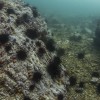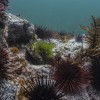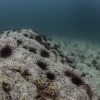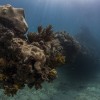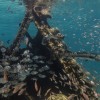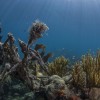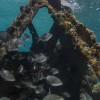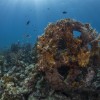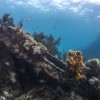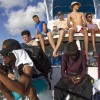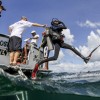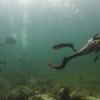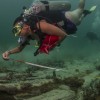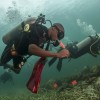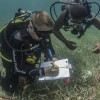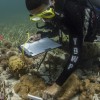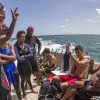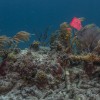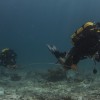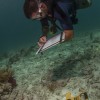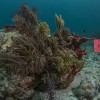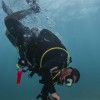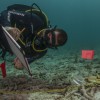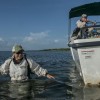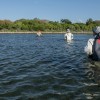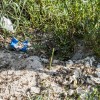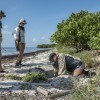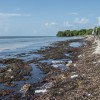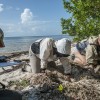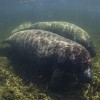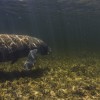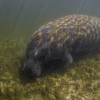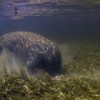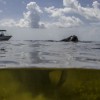My last destination on my adventure led me to American Samoa; arriving on the island after a five-hour flight from Hawaii felt like landing on the edge of the world. It was certainly the farthest west I’d ever been, and my first time in Polynesia. I had been expecting a small island, similar to what I experienced in Kalaupapa, but I was soon overwhelmed by the size and culture of American Samoa. The island was a mix of traditional Samoan culture overlaid by American Westernization. The result? A vibrant, colorful community with both traditional values, modern culture and a stunning landscape.
Pola Island with Red-footed Boobies flying overhead.
Upon my arrival to the island I met with Tim Clark, a marine ecologist in the park. He quickly introduced me to my roommates for the next three weeks: Ian Moffitt, Karen Bryan, Caitlyn Webster and Kersten Schnurle. These four interns arrived around the same time as I did, and were on a mission to kill Crown-of-Thorns starfish, or COTs. Many of the parks I’d worked in had problems with invasive species; in Yellowstone it was lake trout, in Biscayne it was lionfish, and in Crater Lake crayfish were the invasive nuisance. American Samoa’s problem with COTs was unique in that the starfish are a native species, but their population surges or outbreaks have a devastating impact on coral reefs. It’s theorized that increased nutrient runoff from farming and industrialization, combined with strong weather events such as the 2009 typhoon, created a perfect storm for the starfish population to grow unchecked. This is bad news for coral, as the problematic starfish eat hard corals, leaving white skeletons in their wake. 
Some of American Samoa’s beautiful coral specimens.
So with our mission the other interns and I set out to find the COTs outbreaks. To do this we utilized a survey technique called tow-boarding, where two people were towed behind the boat and signaled each time they saw an outbreak. We started tow-boarding in the park, and continued all across the north side of the island, documenting outbreak locations, intensity and depth.
Once we knew where the Crown-of-thorns starfish outbreaks were, we set out to manage the population. To do this injected each COTs with a mixture of water and powdered ox-bile. The ox-bile mixture disintegrates the starfish, and leaves no impact on the reef. Don’t ask me how someone thought to use bile from ox to kill starfish, but hey, it works!  My first dive with the injector was a lesson in task-loading; in addition to carrying our regular scuba gear, we were also equipped with a weighted container of the ox-bile mixture attached to a long injection needle. It was quite a challenge to keep everything sorted out, but I adapted and even managed to kill 11 COTs! It wasn’t quite the record of 100+ on a single dive, but I felt better knowing that I had eliminated at least part of the problem. Diving and tow-boarding in American Samoa gave me the chance to see corals I’d never seen before. The waters of American Samoa boast over 200+ coral species, and being there to see the beautiful reefs was a special privilege.
My first dive with the injector was a lesson in task-loading; in addition to carrying our regular scuba gear, we were also equipped with a weighted container of the ox-bile mixture attached to a long injection needle. It was quite a challenge to keep everything sorted out, but I adapted and even managed to kill 11 COTs! It wasn’t quite the record of 100+ on a single dive, but I felt better knowing that I had eliminated at least part of the problem. Diving and tow-boarding in American Samoa gave me the chance to see corals I’d never seen before. The waters of American Samoa boast over 200+ coral species, and being there to see the beautiful reefs was a special privilege. 


 Halfway through my stay we were joined by Ana Sofia Guerra, the current North American Our-World Underwater Scholar. It was great meeting and catching up on each other’s adventures; what are the odds of meeting halfway across the world?! I also had the opportunity to explore some of the delicious food (and ice cream!), beautiful views and even native fauna. My second evening in American Samoa introduced me to Malie, a baby Samoan fruit bat that had been separated from its mother and was being rehabilitated by the Department of Marine and Wildlife Resources. I completely forgot about my fear of bats, and even held her for a while. Samoan fruit bats are an important part of Samoan culture, and grow to have a wingspan of three feet wide!
Halfway through my stay we were joined by Ana Sofia Guerra, the current North American Our-World Underwater Scholar. It was great meeting and catching up on each other’s adventures; what are the odds of meeting halfway across the world?! I also had the opportunity to explore some of the delicious food (and ice cream!), beautiful views and even native fauna. My second evening in American Samoa introduced me to Malie, a baby Samoan fruit bat that had been separated from its mother and was being rehabilitated by the Department of Marine and Wildlife Resources. I completely forgot about my fear of bats, and even held her for a while. Samoan fruit bats are an important part of Samoan culture, and grow to have a wingspan of three feet wide!
It was with a heavy heart that I left the stunning diving and my newfound friends in American Samoa, and headed to Washington D.C. to present my work from my internship. My travel from American Samoa to D.C. was a huge undertaking; I flew from American Samoa –> Honolulu –> Portland, OR –> Houston, TX –> Washington, D.C. Whew! Once in D.C. I met with Cliff McCreedy, the Marine Resource Management Specialist in the Oceans and Coastal Resources Branch of the Park Service. Cliff had generously taken the time to schedule several meetings for me throughout the week, so I had the opportunity to present my work to Ray Sauvajot, Sande McDermott, Stan Bond, Julia Washburn, Lynne Murdock and Don Wollenhaupt. I was quite nervous about presenting to such an impressive and diverse group of decision makers, but they were all generous with their time and eager to hear about my adventures. I also had time to visit the Oceans Hall in the Smithsonian Museum of Natural History, and even met with Emily Frost, a Smithsonian Ocean Portal editor, writer and producer, and Nancy Knowlton, the Sant Chair for Marine Science. What an honor!
 Meeting with Julia Washburn, the Associate Director for Interpretation, Education and Volunteers. Quite a difference from my usual outfit of a t-shirt and shorts!
Meeting with Julia Washburn, the Associate Director for Interpretation, Education and Volunteers. Quite a difference from my usual outfit of a t-shirt and shorts!
I’m now back home in New Hampshire, and I still can’t believe that this incredible opportunity has come to a close. Traveling across the United States has been a whirlwind of an adventure, and it feels like just yesterday I was just gritting my teeth against the cold water of Yellowstone Lake, or watching Red-footed Boobies wheeling overhead in American Samoa. To capture the breadth of my experiences I’ve put together a website chronicling my adventures; click here to view my website and browse through my blog posts, photos and 3D models.
I know it will take many months, perhaps even years, to fully process all that I’ve done and realize the impact that this internship has had on my career. I continue to be astounded by the generosity of the National Park Service and the Our-World Underwater Scholarship Society as they continue to mentor and advise me on my next adventure. My heartfelt thanks go to both organizations, as without their support I wouldn’t be the aquanaut that I am now. Also many thanks to the amazing people I’ve worked with throughout the past five months; I was amazed by our country’s underwater resources, but I was truly awed, humbled and inspired by the people who protect them.
Thank you.
~Yasmeen Smalley












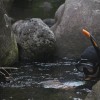
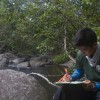
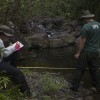






 A gun turret on the USS Utah
A gun turret on the USS Utah




















